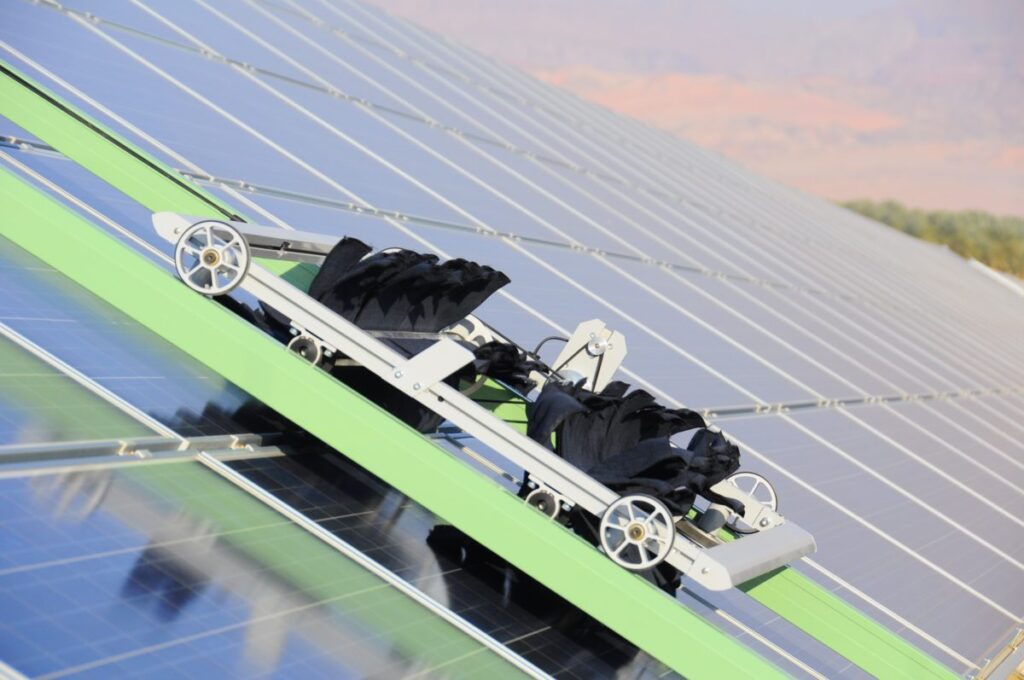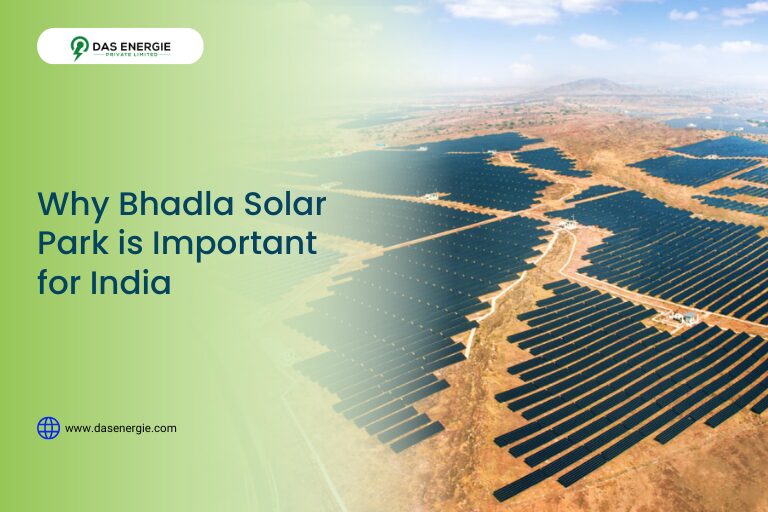Why Bhadla Solar Park is Important for India
The world’s largest solar park is big enough to fit in more than 220 Narendra Modi Stadiums! We are talking about the Bhadla Solar Park located in Jodhpur district, Rajasthan.
The Bhadla Solar Plant is a 2.245 GW solar plant that can annually produce a power of 7,32,874 MWh. It can power over 10 lakh homes. There are more than 1 crore solar panels in this plant.
Over Rs. 10,000 crore was invested in the solar park. It reduces CO2 emissions by 694,471 tonnes annually.
Table of Contents
ToggleHighlights of Bhadla Solar Park (Largest Solar Plant)
Highlight | Description |
Capacity of Bhadla Solar Park | 2,245 MW |
Annual Power Production | 732,874 MWh |
Cost of Creation | Rs. 10,000 crore |
Total Area | 14,000 acres |
Number of Solar Panels | Over 1 crore solar panels |
High-End Technologies Used | Robots for Cleaning Panels, Smart Grid Integration, Dual Axis Tracking System |
Benefits | Reduction of 694,471 tonnes of CO2 annually |
In the video embedded below, you can find the key features of Bhadla Solar power plant.
Video credits to channel: The Hindu
Location of Bhadla Solar Plant
The Bhadla Solar Park is in Bhadla, Phalodi tehsil, Jodhpur district of Rajasthan. It is the largest solar power plant in India, spreading over 14,000 acres. There are several reasons why Bhadla was selected for setting up a solar park. Take a look at some of them:
- The availability of large swathes of barren government-owned land in Bhadla makes it ideal for installing this large solar park for harnessing solar energy.
- The solar irradiation in Bhadla can be as high as 5.7 KWh/sq. metre per day. Thus, the park can utilise solar radiation throughout the year
Significance of Bhadla Solar Park - India’s Largest Solar Power Plant
Bhadla Solar Park marks an important milestone in India’s solar journey. Here’s how it is helping India:
1. Reducing Carbon Emission
Bhadla Solar Park’s annual reduction in CO2 emissions equals planting more than 2 crore trees. It annually reduces close to 7 lakh tonnes of CO2. This CO2 offset is nearly 1 lakh tonnes more than the offset done by Pavagada Solar Park, India’s 2nd largest solar park.
2. Aligning with India’s International Commitment
To understand the significance of this solar park in Bhadla, you need to understand the solar ambitions and potential of India as well as Rajasthan.
PM Narendra Modi announced the ‘Panchamrit’ as India’s response to tackling climate change at the 2021 Glasgow Climate Change Conference. The ambitious targets included:
- Meeting 50% of energy requirements from renewable energy by 2030
- Achievement of net zero by 2070
- Generating 500 GW of energy from non-fossil sources by 2030.
Here’s how PM Modi announced the Panchamrit declaration to the world:
Video credits to channel: Narendra Modi
Thus, the development of Bhadla Solar Park must be seen in the context of India’s international commitments to fight climate change. India aims to generate 100 GW of solar energy by 2026. This solar park is crucial to meet this goal as well.
The government has set a target of installing rooftop installation of 40 GW by 2026. You too can install a home solar system to contribute towards achieving this target. Find the right installer near your location through Das Energie.
3. Achieving Rajasthan Government Solar Energy Target
The National Institute of Solar Energy estimates the solar potential of Rajasthan at 142 GW. According to the Rajasthan Renewable Energy Policy, 2023, the state has set a target of generating 65 GW of solar energy by 2030. Thus, the the solar park utilises the immense potential of Rajasthan for generating solar electricity. Currently, the capacity of the solar park stands at 2,245 MW.
Challenge of Bhadla Solar Park
One major challenge for Bhadla Solar Park is the accumulation of dust on solar panels. As a result, the efficiency of solar panels can be significantly reduced. On top of that, Bhadla faces water scarcity. Cleaning the panels is a top priority at the solar park for effective maintenance. While some developers are using robots, others use water or roller brushes to clean the panels.
Some of the project developers are using robotic technologies to clean the panels. In the following section, we describe how they work.

Technologies Used at Bhadla Solar Park
Here are some notable technologies being used at Bhadla Solar Park:
1. Usage of Robotics Technology for Cleaning
Robotics firm Ecoppia has signed agreements with Engie and SB Energy to deploy its robots for cleaning their solar panels. These robots are nightly deployed and clean the panels without any water.
Here’s a video illustrating how the robots clean the panels at Bhadla Solar Power Plant.
Video credits to channel: Ecoppia
2. Dual Axis Tracking Systems
Bhadla Solar Park has over 1 crore solar panels (as per a BBC report). These panels use tracking systems to track the sun’s movement. To ensure sunlight falls directly on a panel, the solar panels use dual-axis trackers. These trackers follow the movement of the sun in both north-south as well as east-west directions.
3. Smart Grid Integration
Bhadla solar park is grid-connected which means it sends electricity to the grid. It uses smart grid technology to minimise costs, manage power outages, and ensure the grid’s stability. This technology controls the supply and demand of electricity.
4. Weather Forecasting
Radars, satellites, and sensors are used to analyse and forecast the weather. Weather forecasting is important for Bhadla Solar Park because the weather affects the electricity generated by the panels. Cloudy weather, for example, can decrease the sunlight falling on the panels, leading to lower electricity generation.
If you are interested in installing a home solar system with top-notch technology such as galvanised steel, you can connect with us on our platform. Our installers use the best solar components to ensure the high performance and longevity of your solar system.
Development Phases of Bhadla Solar Park
Bhadla Solar Park was developed in 4 phases with different capacities of solar power. Maximum capacity was installed in Phase III. Take a look at the details:
Development Phase | Capacity | Number of Plants | Development Agency |
Bhadla Solar Project Phase I | 75 MW | 7 plants | Rajasthan Solar Park Development Company Limited |
Bhadla Solar Project Phase II | 680 MW | 10 plants | Rajasthan Solar Park Development Company Limited |
Bhadla Solar Project Phase III | 1000 MW | 10 plants | Saurya Urja Company of Rajasthan Limited |
Bhadla Solar Project Phase IV | 500 MW | 10 plants | Adani Renewable Energy Park Rajasthan Ltd |
Capacity Breakdown of Bhadla Projects
SECI and NTPC conducted auctions for developing projects at Bhadla Solar Park. From SB Energy to NTPC, several developers funded the projects.
Here’s a breakdown of the capacity developed by different developers:
Project Developer | Capacity (in MW) |
SB Energy | 600 |
Hero Future Energies | 300 |
NTPC | 260 |
ACME Solar | 200 |
Azure Power | 200 |
Charisma Energy/Sunseap | 140 |
Engie | 140 |
Avaada Power | 100 |
Fortum Solar | 70 |
Vector Green | 70 |
ReNew Power | 60 |
Phelan Energy | 50 |
Electrotherm | 5 |
Aditya Birla | 20 |
LNB Group | 5 |
Roha Dyechem | 25 |
Total Capacity | 2245 |
With a capacity of 2,245 MW, Bhadla Solar Park is an icon of India’s solar power ambitions. It is the largest solar park in India and even the world and can power over 10 lakh homes. It will help India to a large extent to achieve the ‘Panchamrit’ goals announced by PM Modi at the Galsgow Climate Change Conference, including the generation of 500 GW of energy from renewable sources by 2030.
Have any doubts regarding solar systems? Shoot your questions to the energy experts at Das Enegie. Our dedicated team of experts will resolve all your queries. Be it the installation of a system or a simple query, Das Energie is here to meet all your needs.
FAQs
The solar park spans over 14,000 acres. It is the world’s largest solar park.
Bhadla Solar Park can generate solar power up to 732,874 MWh annually. It has a capacity of 2,245 MW.
Big names among the developers at Bhadla Solar Park include SB Energy, NTPC, and Hero Future Energies.
Technologies deployed at Bhadla Solar Power Plant include dual-axis trackers in solar panels, robots for cleaning the panels, and smart grid integration.
Over Rs. 10,000 crore was invested in the solar park.
Bhadla Solar Park was developed in 4 phases. The Rajasthan Solar Park Development Company Limited developed the initial 2 phases, Saurya Urja Company of Rajasthan Limited developed the 3rd phase, and Adani Renewable Energy Park Rajasthan Ltd developed the 4th phase.

